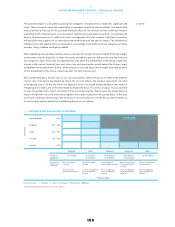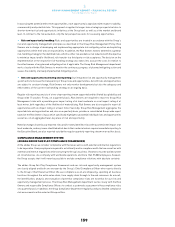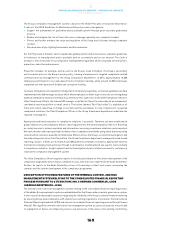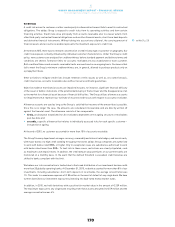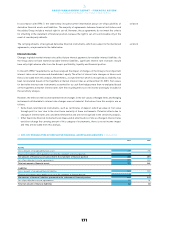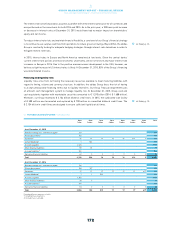Reebok 2015 Annual Report Download - page 168
Download and view the complete annual report
Please find page 168 of the 2015 Reebok annual report below. You can navigate through the pages in the report by either clicking on the pages listed below, or by using the keyword search tool below to find specific information within the annual report.
164
3
GROUP MANAGEMENT REPORT – FINANCIAL REVIEW
Risk and Opportunity Report – Illustration of Material Risks
To mitigate competition risks, we continuously monitor and analyse competitive and market information
in order to be able to anticipate unfavourable changes in the competitive environment rather than reacting
to such changes. This enables us to proactively adjust our marketing and sales activities when needed.
Continuous investment in research and development ensures we remain innovative and create a point
of difference from competitors. We also pursue a strategy of entering into long-term agreements with
key promotion partners such as FC Bayern Munich or Lionel Messi, as well as adding new partners to
refresh and diversify our portfolio, e.g. Manchester United or James Harden. In addition, our product and
communication initiatives are designed to increase brand desire, drive market share growth and strengthen
our brands’ market position.
Risks related to media and stakeholder activities
The adidas Group faces considerable risk if we are unable to uphold high levels of consumer awareness,
affiliation and purchase intent for our brands. Adverse or inaccurate media coverage on our products or
business practices as well as negative social media discussion may significantly harm the Group’s reputation
and brand image, lead to public misperception of the Group’s business performance and eventually result
in a sales slowdown. Similarly, certain activities on the part of key stakeholders (e.g. non-governmental
organisations, governmental institutions) could cause reputational damage, distract top management and
disrupt business activities.
To mitigate these risks, we pursue proactive, open communication and engagement with key stakeholders
(e.g. consumers, media, non-governmental organisations, the financial community) on a continuous basis.
In addition, we have established clear crisis communication processes to ensure a quick and effective
response to adverse developments. We have also strengthened social media capabilities across the Group
and created various digital newsrooms worldwide that enable continuous monitoring of social media content
related to the Group’s products and activities and allow early management of potentially damaging social
media discussion. On a case-by-case basis, we seek external advice from experts in communication and
stakeholder management.
Macroeconomic, sociopolitical and regulatory risks
Growth in the sporting goods industry is highly dependent on consumer spending and consumer confidence.
Economic downturns and sociopolitical factors such as military conflicts, changes of government, civil
unrest, nationalisation or expropriation, in particular in regions where the Group is highly represented,
therefore pose a significant risk to the Group’s business activities and top- and bottom-line performance.
In addition, substantial changes in the regulatory environment (e.g. trade restrictions, tax legislation,
economic and political sanctions, etc.) could lead to potential sales shortfalls or cost increases.
To mitigate these macroeconomic, sociopolitical and regulatory risks, the Group strives to balance sales
across key global regions and also between developed and emerging markets. We also continuously
monitor the macroeconomic, political and regulatory landscape in all our key markets to anticipate potential
problem areas, so that we are able to quickly adjust our business activities accordingly upon any change
in conditions. Potential adjustments may be a reallocation of investments to alternative, more attractive
markets, changes in product prices, closure of own-retail stores, more conservative product purchasing,
tight working capital management and an increased focus on cost control. In addition, by building on our
leading position within the sporting goods industry, we actively engage in supporting policymakers and
regulators to liberalise global trade, curtail trade barriers and proactively adapt to significant changes in
the regulatory environment.
see Research and
Development, p. 80






